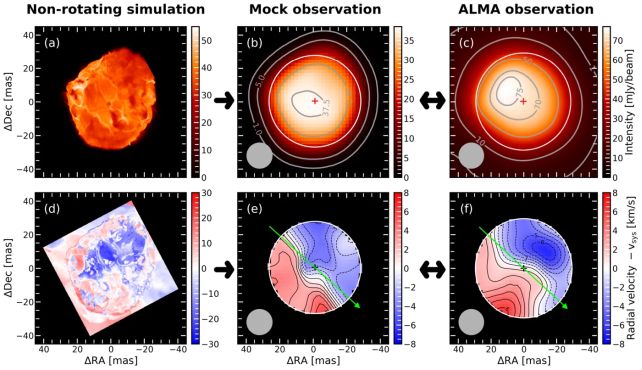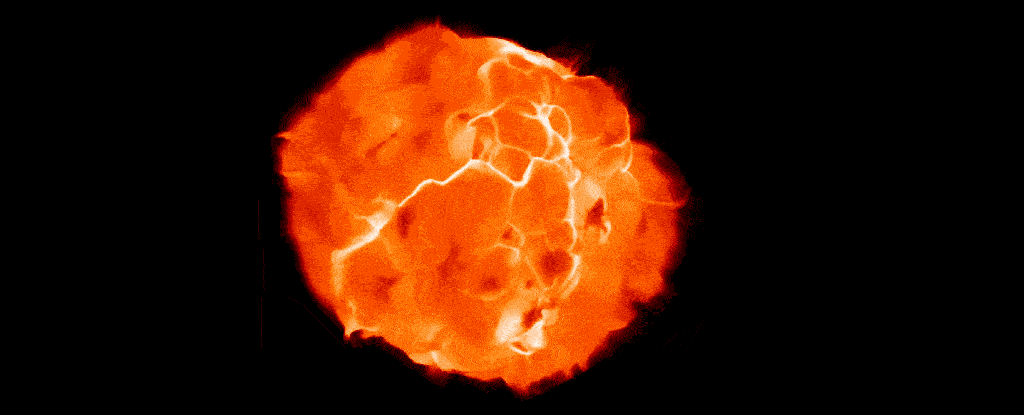Products You May Like
There’s something peculiar about dying star Betelgeuse.
Yeah, there was the whole sneeze thing. That’s been pretty much resolved for now. But before the Great Dimming Debacle of 2019, scientists spotted something even more peculiar about the giant star. Radio measurements of its changing light suggested it was rotating at 5 kilometers (3.1 miles) per second.
The big problem with that is that stars of Betelgeuse’s vintage should, theoretically, have a maximum rotation speed at least two orders of magnitude lower. So, astronomers wonder, what the heck gives?
Well, according to new research, it may have been a big old tricksy-doodle. A team led by astrophysicist Jing-Ze Ma of the Max Planck Institute for Astrophysics in Germany has found that Betelgeuse’s boiling surface could be so riotous that it generates an illusion of fast rotation.
Rotation in stars is measured by carefully analyzing differences in light from opposite sides of a star. Light from the side of the star moving towards the view (that’s us) gets a little bit of a boost that squishes it towards the blue end of the spectrum, while light from the side moving away from us is stretched towards the red end.
Scientists can measure the amplitude of this blueshifting and redshifting to determine how fast a star is rotating. Well, a typical quiet star, anyway. The problem is that Betelgeuse is not quiet. It’s at the red supergiant stage of its lifespan; it’s running out of nuclear fuel and has puffed up to a tremendous size, with a surface roiling with convection.

Hot material bubbles up, cools, and falls down. This happens on the Sun, too, with convection cells the size of Texas, but the process is much more violent on Betelgeuse, with convection cells that can be as large as Earth’s orbit around the Sun (Betelgeuse is large enough to extend as far as Jupiter’s orbit).
Ma and his colleagues wanted to know if this convection could provide an alternative explanation for what we previously interpreted as ultrafast rotation in observations from the Atacama Large Millimeter/submillimeter Array (ALMA)– so they turned to 3D simulations.
They created models of red supergiant stars like Betelgeuse, governed by giant convection, that aren’t rotating, and then processed the results as synthesized observations from ALMA.
Their simulations showed huge convective cells that rise on one side of the red supergiant, while another cluster collapses and falls inward on the other. ALMA doesn’t have the resolution to identify these as convective cells; instead, data from the telescope can look very similar to rotation.
In fact, the researchers showed that, in 90 percent of the simulations, observations made using ALMA would look like rotation at a rate of several kilometers per second.
frameborder=”0″ allow=”accelerometer; autoplay; clipboard-write; encrypted-media; gyroscope; picture-in-picture; web-share” allowfullscreen>
It’s not hard proof that Betelgeuse isn’t rotating at a super-fast speed, though it does show that we can’t make a conclusion based on the data we currently have to hand. But more high-resolution observations have been made, and are being processed and analyzed. These should give us more clues about what the heck the star is doing.
Either way, the results will be interesting. If Betelgeuse is spinning around like a deranged whirligig, it could mean the red supergiant gained spin by devouring a smaller companion star. If it’s rotating more sedately, we’ve learned to proceed with more caution when interpreting the data we collect on unstable stars.
“There is so much we still don’t understand about gigantic boiling stars like Betelgeuse,” says astronomer Andrea Chiavassa of the French National Centre for Scientific Research.
“How do they really work? How do they lose mass? What molecules can form in their outflows? Why did Betelgeuse suddenly get less bright? We are working very hard to make our computer simulations better and better, but we really need the incredible data from telescopes like ALMA.”
The team’s research has been published in The Astrophysical Journal Letters.
